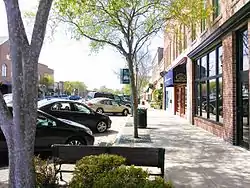Fuquay Springs Historic District | |
 Fuquay Varina Downtown, April 2014 | |
  | |
| Location | Roughly, S. Main St. and Fuquay Ave. from Spring St. to Sunset Dr. and Spring St. from Spring Ave. to Angier Rd.S. Main Street on the east; Sunset Drive on the south; Kite Drive on the west; W. Spring Street on the north, Fuquay-Varina, North Carolina |
|---|---|
| Coordinates | 35°34′49″N 78°47′55″W / 35.58028°N 78.79861°W |
| Area | 23.26 acres (9.41 ha) |
| Built | c. 1899 |
| Architect | Hairr, A. Y. |
| Architectural style | Queen Anne, Colonial Revival, Tudor Revival, Bungalow/craftsman |
| MPS | Wake County MPS |
| NRHP reference No. | 96001398, 14000230 (Boundary Increase)[1] |
| Added to NRHP | November 29, 1996, May 19, 2014 (Boundary Increase) |
Fuquay Springs Historic District is a national historic district located at Fuquay-Varina, Wake County, North Carolina. The districts encompasses 36 contributing buildings and 1 contributing site in the town of Fuquay-Varina. The predominantly residential district developed between about 1899 and 1946, and includes notable examples of Queen Anne, Colonial Revival, Tudor Revival, and Bungalow / American Craftsman architecture. Located in the district are the separately listed Ben-Wiley Hotel and Fuquay Mineral Spring. Other notable buildings include the Varina Mercantile Building (1899), Barham Hotel (c. 1908), Ballentine-Spence House (c. 1910, 1927), Barbour-Perkins House (c. 1928), Proctor House (1925), and Harold Johnson House (1938).[2][3]
It was listed on the National Register of Historic Places in 1996, with a boundary increase in 2014.[1]
References
- 1 2 "National Register Information System". National Register of Historic Places. National Park Service. July 9, 2010.
- ↑ Beth P. Thomas (June 1996). "Fuquay Springs Historic District" (pdf). National Register of Historic Places - Nomination and Inventory. North Carolina State Historic Preservation Office. Retrieved June 1, 2015.
- ↑ Sybil H. Argintar (December 2013). "Fuquay Springs Historic District (Boundary Increase)" (pdf). National Register of Historic Places - Nomination and Inventory. North Carolina State Historic Preservation Office. Retrieved June 1, 2015.

